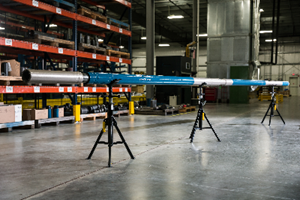Downhole tools and technologies driving performance improvements in the Permian
HOUSTON -- The Permian basin continues to be a hotbed of drilling activity, bolstering North American output to record levels. The need for profitability and greater efficiencies in the region is driving operators to implement solutions that will drive their project costs down, yet wells are also growing in complexity. In challenging wells, proven solutions that unite downhole tools and technologies will be the differentiator.
NOV’s agitator system has surpassed 10,000 runs in the Permian basin. The downhole tool increases ROP, improves weight transfer, and decreases stick-slip by reducing downhole friction in directional drilling applications. ERT power sections dramatically improve motor ROP by providing up to two times more power to the drill bit than conventional power sections of the same length. The Vector Series 50 drilling motor provides strength and reliability with a short bit-to-bend length, allowing superior directional performance and the ability to drill a curve and lateral in a single run.
The technology, equipment and service provider recently worked with a major operator in the Permian to increase their drilling performance, with the operator using a 6¾-in. agitator system to drill the complete lateral interval to total depth (TD). Though one trip in the lateral section was made to swap BHA components, the Agitator system was reused to reach TD. The total footage drilled was 7,167 ft and the well was completed in 76.8 hr, which was 12.42 hr less when compared to the same interval as the offset well. The offset well used a similar BHA with a competitor vibration tool. The strong performance using the system led the operator to switch to NOV’s tool in other wells.
Another operator in the Permian reported the longest one-run, conventional run in the Midland Basin on the Wolfcamp formation using an integrated equipment and technology package. By implementing a combination of a Vector Series 50 motor with ERT power section and agitator system, the operator was able to drill the total 10,520-ft lateral at an ROP of 126.3 ft/hr. The operator noted that the tools were consistent in improving drilling performance and that the service being provided exceeded their expectations. On a separate project with the same operator, the objective was set as increasing ROP while minimizing bit damage on a two-well pad. In the first run using an ERT power section, the operator drilled the 12¼-in. intermediate section, from 500 ft to 9,200 ft, and achieved an average ROP of 160 ft/hr. The section was completed in one run and the bit was pulled in excellent condition.
The Permian will continue to be an area of interest as horizontal drilling accelerates, and for onshore shale drilling in North America, the necessity of performance increases and efficiency gains is apparent. As companies ramp up their drilling operations and work to optimize horizontal drilling performance from well to well, the role of downhole tools as drivers of ROP increases and consistency gains will be solidified. Identifying the best technologies and techniques will be critical, and proven solutions will outperform the competition.



